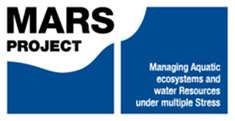Change in thermal, mixing or ice regime
The temperature, layering and mixing of European water bodies, and their interactions with snow, glacier and permafrost cover, are predicted to be significantly influenced by future climate change. Climate change in Europe is increasingly evident through warming air and water temperatures and altered precipitation patterns; trends that are predicted to continue in coming decades as a result of ongoing anthropogenic emissions of greenhouse gases (EEA 2015). Whilst the impacts of climate change are predicted to be uneven across the continent, existing environmental vulnerabilities are predicted to be intensified; for example, exacerbating water temperature increases, water scarcity and drought in regions of Southern Europe (EEA 2012, EEA 2015).
Pressure types
There are a number of thermal pressures generated by different drivers:
Climate Change
Climate Change - lake warming can cause algal blooms and eutrophication, particularly in shallow lakes when nutrient concentrations are also high. Increased water temperatures place pressure on aquatic biodiversity, often lowering dissolved oxygen concentrations in the water (known as ‘hypoxia’), increasing organism respiration rates and potentially creating altered habitat conditions conducive to invasive species.
Changes to lake mixing - lakes – particularly those which are large and deep – have water columns comprised of layers of water at different temperatures, which undergo natural processes of exchange and mixing, causing the vertical movement of dissolved oxygen, nutrients and sediments. Warming lake temperatures can cause such ‘conveyer belt’ systems to change or even cease, impacting the structure and health of the aquatic ecosystem.
Stagnation - climate changes may cause small streams and lakes to become stagnant, as decreased water inputs reduce water mixing alongside water temperature increases, which can have negative impacts for biodiversity, particularly macroinvertebrate and fish communities.
Ice melt - the extent of glacier, snow and permafrost coverage are all decreasing across Europe, producing significant quantities of cold meltwater into nearby water bodies in the short-term, and potentially compromising the headwater sources of water for many mountain streams and rivers in the longer-term (EEA 2015).
Energy
Hydropower - hydropower projects generate electricity in response to demand, which means that the water flows they subsequently release can be highly variable. Such pulses of water can significantly alter the quantity, speed and temperature of water flows downstream in a short period of time: a phenomenon known as ‘hydropeaking’. Hydropeaks can rapidly alter the thermal conditions of the downstream aquatic ecosystem, often by releasing water at a higher temperature than the receiving water body (i.e. ‘thermopeaking’. (REFORM 2015a).
Industry
Cooling processes - significant quantities of water are used for cooling in many industrial processes, meaning that wastewater may be emitted at a higher temperature than the receiving water body, creating temperature ‘hotspots’ around emission areas.
Geographical distributions and trends
The impacts of future climate change are predicted to be uneven across Europe: with broadly warming climates across the continent coupled with increased rainfall and floods in Northern Europe and reduced rainfall and drought in Southern Europe (EEA 2012, EEA 2015). Temperature rises are predicted to be largest in mountainous regions and in Southern Europe, whilst Central and Eastern Europe are predicted to experience an increase in warm temperature extremes (EEA 2012, EEA 2015). Glaciers, permafrost and snow cover are predicted to steadily decrease in coming decades across the Arctic Circle and mountainous areas, and coastal zones are predicted to experience increases in sea levels and sea surface temperatures (EEA 2012, EEA 2015).
There are around 23,000 hydropower plants in EU-27 countries, of which 7,700 are in Germany, whilst Austria, France, Italy and Sweden all have more than 2,000 hydropower plants each, many of which are located in mountainous regions (EEA 2012).
Stressors generated
Changes to water body temperature (e.g. through climate warming or hydropeaking) cause thermal stressors, which are linked to chemical stressors (e.g. risk of eutrophication) and biological stressors (e.g. vulnerability to invasive species).
Potential for mitigation
A key strategy for increasing the resilience of freshwater ecosystems to the adverse thermal impacts of climate change is adaptive ecosystem restoration. The protection and restoration of riparian woodland and vegetation has been shown to help control temperature extremes in water bodies through shading, especially in smaller streams (REFRESH 2010).
Similarly, natural water retention methods such as the restoration of natural river courses and flows, wetlands and flood plains can help maintain sufficient ecological flows through catchments, and buffer against extremes of rainfall and water temperatures (EU 2012). A key concern for mitigating the effects of thermal pressures from climate change is to prevent water bodies from crossing ‘tipping point’ thresholds (e.g. in a warming, algae-dominated lake) to new ecological regimes which are difficult to restore (REFRESH 2010).
Mitigation strategies for hydropeaking involve structural measures, such as the creation of basins which buffer high discharges through temporary retention, or the diversion of discharge water into parallel channels; and operational measures, which set minimum and maximum water flow levels, reduce discharge extremes and the frequency of discharge peaks through changes to operational practices in hydropower plants.
Further reading
Reports and publications:
EC (2013). A Water Blueprint for Europe (Download report, 1.28mb)
EEA (2012). European waters - assessment of status and pressures (Download report, 28mb)
EEA (2015). The European Environment - State and Outlook 2015 - Urban Environment (Download report, 15.8mb)
REFRESH (2014). Science Policy Brief 2- Riparian Forest can help mitigate climate warming effects in lowland temperature streams (Download report, 200kb)
Selected Freshwater Blogs:
Freshwaterblog (2015). Low water and high salinity: the effects of climate change and water abstraction on lake ecosystems (External website)
Freshwaterblog (2015). MARS Lake Experiments in the UK (External website)
Freshwaterblog (2017) Largest freshwater Mediterranean lake may dry out in this century due to climate change and abstraction (External website)
Freshwaterblog (2017). Lake Restoration and Management in a Changing Climate (External website)
Other websites:
REFORM (2015). Alteration of riparian vegetation (External website)



